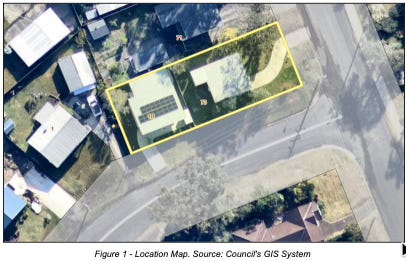Everyone agrees we need more housing—and that sprawl into greenfields isn’t the answer. Infill development, done right, can make our towns stronger, more walkable, and more affordable to service in the long run.
You will know that I am a strong supporter of in-fill and missing middle housing.
But there’s a catch: when policy is weak or unclear, infill becomes a loophole rather than a plan. What looks like a simple case-by-case approval can snowball into traffic conflicts, parking chaos, and the slow erosion of our neighbourhood character.
The Case at Sanctuary Point
Council is currently considering an application at 73 Sanctuary Point Road. On paper, it’s modest: reclassify an already-built “secondary dwelling” as a detached dual occupancy. The only reason it needs special permission is the lot size—626 m² instead of the 700 m² minimum.
The proposal fixes earlier issues with parking manoeuvring and landscaping. And being on a corner block, the access arrangements are workable. There’s no new building bulk, no additional shadowing or height.
On this site, it’s hard to object. It’s infill housing without a hammer hitting the skyline.
The Real Risk: Death by a Thousand Cuts
But let’s not kid ourselves. Every time Council waves through a “Clause 4.6 variation” like this, it quietly moves the goalposts. A 10% size shortfall here, a corner-lot exemption there—soon enough, the 700 m² rule is meaningless.
And when that happens, we don’t just get more houses. We get:
More driveways and crossovers, eating into kerbside parking, street trees, and footpaths.
More traffic pinch points in neighbourhoods never designed for higher dwelling yields.
Subdivision pressure on undersized lots, locking in patterns of development without the usual infrastructure checks.
One by one, the approvals don’t look like much. But together, they add up to ratepayer headaches that last for decades.
Why Infill Matters (Strong Towns Lessons)
This is where Strong Towns thinking is essential. For years, they’ve shown what many councils—including Shoalhaven—try to ignore: greenfield expansion is financially unsustainable.
Every new road, water main, and footpath in the suburbs becomes a long-term liability for ratepayers, who are stuck maintaining it forever—even when the tax revenue from those new houses doesn’t come close to covering the cost.
Infill and “missing middle” housing—townhouses, duplexes, small apartments—by contrast, add value inside the existing network. The pipes, streets, and services are already there. Instead of spreading thin, you build resilience.
Strong Towns analysis repeatedly shows that infill housing produces a much higher return per acre in rates revenue, meaning councils can actually afford to fix roads and fund services without endless debt or state bailouts.
Shoalhaven is already struggling with infrastructure backlogs. Approving sprawl developments today means we are signing our kids up for tax hikes and service cuts tomorrow.
That’s why infill is not just a housing issue—it’s a financial survival strategy.
What Infill Should Look Like
Shoalhaven has two choices: continue “drift by exception,” or get serious about a proper infill policy. That means:
Mapping clear infill areas in big towns—Nowra-Bomaderry, Ulladulla, Vincentia/Huskisson, Sanctuary Point, Berry.
Setting lot size rules that everyone can see up front—say, 600 m² (or 550 m² on corners) inside those areas, with strong design controls.
Requiring landscaping, manoeuvring, and crossover limits to protect verges, trees, and walkability.
Aligning approvals with Shoalhaven Water and waste servicing plans so networks aren’t overloaded by stealth.
In other words, yes to more housing—but no to planning by loophole.
A Call to Councillors
When this DA comes before Council, the question isn’t really about Sanctuary Point. It’s about whether Shoalhaven has the courage to set a clear path for infill, instead of letting policy die the death of a thousand cuts.
So here are the questions councillors should be asking the CEO:
How many sub-700 m² “exceptions” have already been approved, and where?
What safeguards are in place to prevent crossover creep and verge loss?
When will a proper Infill Housing Strategy be brought forward—so ratepayers know the rules, and so developers don’t get rewarded for gaming the system?
Most importantly: how much future maintenance cost is council locking in by continuing to chase suburban expansion instead of strengthening our existing towns?
Because if we want infill to work—and I believe we do—Shoalhaven needs more than workarounds. It needs rules that protect our neighbourhoods while still delivering the housing and financial sustainability we urgently need.
Please share this with 2 friends who care about Shoalhaven.
If you get value from this post and you want to help me with information applications to get to the bottom of issues,you can donate here.
Thank you for considering this, the posts will always be free - but I could do with some help :) Here are thecurrent applications to council,seeking documents.
Here is a quick disclaimer, orexplainer on the use of AI in the Eye.



